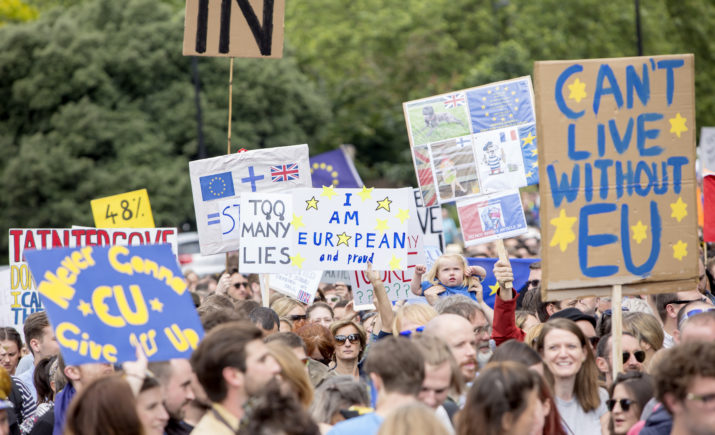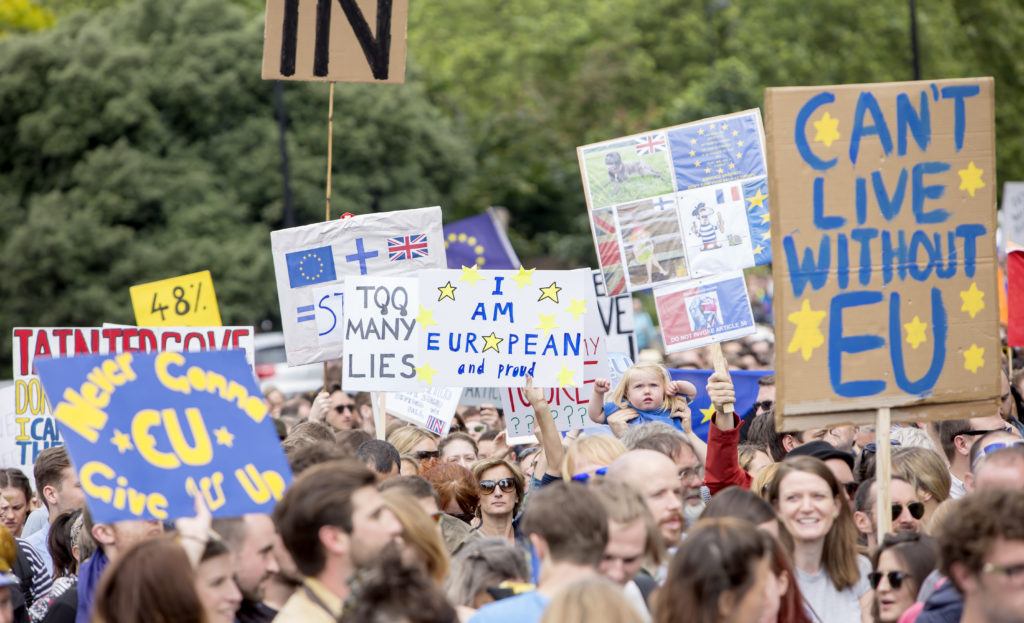

On June 23, 2016, Britain held a referendum to determine the future of its relationship with the European Union. As most surveys predicted, a small margin of victory for the “Remain” campaign (Huffington Post 2016), the referendum results came as something of a shock: 51.9 percent of UK voters cast their preference to “Leave” the EU, while 48.1 percent hoped to “Remain.” According to most post-Brexit analyses, “immigration” was the single strongest issue driving Brits to vote Leave. While immigration has long been an important mobilizing force for political conservatives in the UK, this referendum was different, as voters cast their ballots just as the influx of asylum seekers into Europe was reaching its peak. The confluence of these two events opened a unique opportunity for the political Right, and particularly UKIP (United Kingdom Independence Party), to fundamentally reshape the language of “immigration.” By blurring the boundaries between EU and non-EU, economic and humanitarian, and legal and illegal migration, the Leave campaign challenged established notions of membership, nationality, and human rights in a democratic vote, and won. While the long-term effects of the Referendum will only be clear after the dust of the post-Brexit era settles, there is no doubt that a new status quo in the debate on immigration in Britain has emerged.
The UK’s referendum to leave the EU was an unequivocal demonstration of the anti-establishment sentiments, xenophobia, populism, and Euroscepticism that had already emerged elsewhere across Europe at this time (Hobolt 2016). The Labour-backed Remain side, working under the slogan “Britain Strong IN Europe,” ran a purely fact- and figure-based campaign focused squarely on positive messaging about the economic benefits of EU membership. While the Leave side (both the official Vote Leave and unofficial “parallel” campaign run by UKIP’s Nigel Farage) ran a deeply emotional campaign urging Britons to “take back control.” The overarching concern for these “Leavers” was immigration—a multidimensional and cross-cutting lens through which all relevant campaign issues (borders, sovereignty, social services, British culture, and security) could easily be filtered (Vasilopoulou 2016). This strategy worked. When it came to casting a ballot in 2016, immigration was also cited as the primary issue motivating people to vote for leaving the EU (NBC News 2016).
In some ways, the centrality of “immigration” to the Leave victory during the 2016 referendum is not surprising. Anti-immigration sentiment existed in Britain long before the referendum. An IPSOS Mori poll found that nearly 50 percent of respondents felt immigration was one of the most pressing issues in the UK in 2014, dwarfing other issues like the economy (27 percent), unemployment (17 percent) and crime (13 percent) (Brinded 2015), and 55 percent of Brits wanted to curtail immigration (Pew 2015). Extensive academic study also tells us that the profile of a typical populist and Eurosceptic voter is someone who possesses a strong national (i.e. British) identity (Ford and Goodwin 2014) and is more likely to be hostile to minority or immigrant groups (Hobolt and Wittrock 2011). So, the Leave campaign’s message simply tapped into this pre-existing societal undercurrent.
But the story is exceptional in one critical way. At the same time the UK was ramping up for the referendum, Europe was facing the biggest refugee crisis since WWII, with numbers of asylum seekers from the Middle East reaching over 1 million by 2015. While continental Europe scrambled to control this influx with redistribution schemes, quota systems, fences, increased border and sea patrols, and media campaigns to both welcome and dissuade refugees, the UK sat in a relatively unique position. Geographically more difficult to reach and not technically part of the Schengen Zone, Britain possessed comparatively more autonomy over its borders than other nations on the continent.
Compared to other countries in the EU, the UK also saw one of the lowest numbers of asylum applications, with just over 39,000 asylum applications in 2015, compared with Germany’s 441,800 asylum applications in 2015, France’s 70,570, Italy’s 83,245 and even Hungary’s 174,435 (Eurostat 2016). Put another way, the UK received just sixty applications per 100,000 people (the EU average was 260 per 100,000 people). And yet, Britain’s opposition to accepting refugees was some of the most vocal in Europe. Polls showed that the number of Britons hoping to close borders to refugees increased by four points from October to December of 2015 (Nardelli 2015). And according to a 2016 Pew survey (Pew 2016), 70 percent of UK citizens polled “disapproved” of how the EU was dealing with the refugee crisis (compared with 67 percent of Germans, 70 percent of French, 77 percent of Italians and 72 percent of Hungarians). This negative public opinion could easily be a gold mine for the political opportunism of the Right.
There has always been an intersection between populist politics and media discourse, and there is strong evidence that fear-based messages appear during important political and electoral markers, like elections, in liberal nations (Gale 2014). Sure enough, all across Europe at this timeHungary, France, Germany, Sweden, Denmark, the Netherlands, Austria—far-right parties were taking advantage of public opinion surrounding the Syrian refugee situation to leverage their own populist political agendas, to either gain or secure power. Would Britain be the same? Would political parties like the far-right UKIP, use the refugee crisis to boost the Leave message, particularly with the stakes so high leading up to the Brexit vote? Unsurprisingly, the answer is yes. The crisis acted as something of an exogenous shock to a campaign already focused on immigration and was a political opportunity that was hard to pass up.
In reality, the UK’s membership in the EU would have very little effect on the country’s responsibilities concerning the refugee crisis, as the UK had already opted out of common EU asylum policies and instead was bound only by a distinct set of international conventions. Leaving the EU would only address Britain’s concerns over immigration by restricting the free movement of people originating from within the EU member states (i.e. EU citizens), namely economic migrants, students, or those reuniting with families. However, this did not stop the Leave campaigners from crafting a staunchly anti-immigrant message that (purposefully) obscured the important political and legal distinctions between these two anomalous groups—EU citizens, and asylum seekers and refugees. By erroneously lumping these categories of migrants together and recasting them in the minds of potential voters as a homogenous “immigrant” population, the Leave campaign could more easily tap into a broader spectrum of fears concerning economics, security, race, culture, and sovereignty than a focus on any one of those categories alone would permit.
A closer look at the Leave campaign materials quickly reveals this tactic of “sloppy labeling” with respect to the immigration debate. The first feature of note is the use of terminology. Using the umbrella term “migrant” instead of “refugee” to refer to people fleeing war zones in the Middle East and entering Europe itself sends a strong message. It can be seen as a way to blunt and dehumanize the crisis in the Mediterranean, to render the crisis less severe and to devoid it of the aspect of human suffering worthy of humanitarian concern (United Nations 2015). Research on major newspapers has shown that while Germany (91.0 percent) and Sweden (75.3 percent) overwhelmingly used the terms “refugee” or “asylum seeker,” in Britain the more common term is “migrant” (54.2 percent). As the majority of refugee stories in conservative presses are sourced from the Conservative party and UKIP (as high as 90 percent in the case of the Daily Telegraph), this indicates that these parties are also more inclined to use the terminology of “migrant” as opposed to “refugee.” As a result, the Leave campaigns could invoke the negative imagery and fear associated with the influx of refugees to amplify existing anti-EU migration sentiments. Yet, without using the terminology of “refugee,” the Leave campaign not only stripped the humanity from the crisis, but also misled voters by implying that the forces guiding and controlling both the refugee crisis and internal EU migration were the same and could both be solved by leaving the EU.
To gauge the extent to which these imprecise immigration messages appeared in the actual campaigns, I analyzed a total of forty-five campaign posters (nineteen posters from Remain/Britain Stronger in Europe, ten posters from Leave, and sixteen from Leave.EU/Grassroots Out/UKIP), as well as hundreds of leaflets available in the LSE Digital Library “Brexit” collection (LSE Digital Library 2016) distributed by both campaigns and NGOs. A few key patterns emerged.
Of the ten official Vote Leave posters only three openly expressed the slogan to “take back control” in a negative sense, citing threats of “foreign criminals” and high “immigration” rates. Only one made indirect reference to the refugee crisis and the proposals to give Turkey visa free travel to the Schengen Area (which Britain is not a part of). The poster reads “Britain’s new border is with Syria and Iraq,” implying that using Turkey as a conduit, refugees from the Middle East can now access the UK unfettered (See Figure 1). This is a recurring graphic from the official Vote Leave campaign, which demonstrates a fear of “prospective members,” namely Albania, Serbia, Montenegro, Macedonia, and Turkey. The obvious implication from this imagery is that once these new states enter the EU they will serve to open the land route for migrants from bordering countries like Syria and Iraq, the current source for the migrant crisis.

Figure 1. Sample Leave Poster
While the official Vote Leave campaign tends towards more implicit references to the crisis, the unofficial UKIP campaign errs on the side of explicit mention, frequently invoking the language of “terrorism,” “Jihad,” “ISIS,” and “violence.” The most controversial example is Grassroots Out’s “Breaking Point” poster, which Nigel Farage unveiled on his battle-bus a week before Referendum day (See Figure 2).

Figure 2. UKIP Poster “Breaking Point”
The poster actually pictures a line of non-EU refugees crossing the Croatia-Slovenia border, although the poster was meant to draw attention to the urgency in ending the era of free movement within the EU. The poster, which was released the day of MP Cox’s tragic murder, was widely condemned in political circles and opposition Labour Party member Yvette Cooper declared: “Just when you thought ‘leave’ campaigners couldn’t stoop any lower, they are now exploiting the misery of the Syrian refugee crisis in the most dishonest and immoral way” (Evening Standard 2016). Rife with factual inaccuracies, the poster very purposefully conflated the identities and statuses of EU migrants with asylum seekers in order to exploit the climate of fear and mistrust that had been growing in British society.
In many cases, the Leave campaign simply talks about “migrants” (not “refugees”), but the bulk of the language and imagery used is meant to illicit a mental connection with the refugee crisis. Although the terms themselves are not always used interchangeably, the lack of subtlety signals a deliberate tendency to omit clarifying details in the hopes that the audience will make the mental connection themselves. In stark contrast to all of this, any direct or indirect reference to the refugee crisis is almost entirely absent from the Remain camp. In fact, on multiple occasions, even reference to “migrants from outside the EU” is qualified explicitly with the term “economic” to make it clear that they are not referring to refugees or asylum seekers.
What are the consequences of such a campaign tactic? In the short term, the obvious consequence of such a campaign is an increase in overall support for the anti-immigrant message of the Leave campaign. There is no shortage of scholarly evidence to suggest that voters can be receptive to negative messaging concerning immigrants and other ethnic minorities. The idea of racially coded campaign appeals has long been discussed by academics, particularly in the case of the United States. This is the use of racial or other content to trigger attitudes relevant to voter decision-making by tapping into existing attitudes held by the population. When the appeals are explicit, they might violate norms of racial equality that voters find distasteful, but when the message is implicit, those norms are not violated and the effect on voting behavior is subliminal. In the case of the UK, we see both implicit and explicit references to the refugee crisis by the Leave campaign. Hopkins (2010) also suggests that in locations where immigration is perceived to be increasing, the addition of a nationally salient (and negative) political message about immigration can greatly increase individual anti-immigrant attitudes as well as voting behavior in favor of more restrictive measures. During the Brexit campaign, the refugee crisis was certainly a nationally salient event. The sheer media and political force of this crisis helped provide the space for the Leave campaign to activate their anti-immigrant message with reference to a real-time catastrophe. The subsequent Referendum then gave Brits a chance to translate those sentiments into a vote for restricted freedom of movement.
Survey data suggests this was exactly what happened in 2016. Initially, when people were asked about accepting refugees versus economic migrants into the country independent of their voting intentions in the EU referendum, polls indicate much more tolerance for accepting those seeking asylum from the Syrian war than those coming for economic reasons (roughly 45 percent of those asked about Syrian refugees said they would want either “higher numbers than recently” or to “keep the numbers coming here about the same” (What UK Thinks: EU 2015a), whereas less than 20 percent of respondents indicated the same for economic migrants (What UK Thinks: EU 2015b)). Yet, this sympathetic outlook towards accepting refugees disappeared when people were asked about refugees in the context of EU membership: 45 percent of people polled indicated that leaving the EU would be the best way to deal with the refugee crisis in the UK (What UK Thinks: EU 2016a).
Voters also expressed a direct link between the refugee crisis and their voting intentions in the EU Referendum. In a poll at the height of the refugee crisis in December 2015, 45 percent of respondents said that the refugee crisis in Europe made them more likely to vote Leave, 32 percent said it would have no effect and only 10 percent said they would be more likely to vote remain (What UK Thinks: EU 2015c). Among those self-reported Remain supporters surveyed in another poll, roughly 21 percent indicated that should the migrant crisis continue to get worse they would consider switching their vote to Leave (What UK Thinks: EU 2015d). Even Nigel Farage’s “Breaking Point” poster, arguably one of the most inflammatory campaign tactics used, did not sour the enthusiasm of Brits for voting Leave early as much as we might expect. According to a 2016 poll asking “Do you think that the ‘breaking point’ poster launched by Nigel Farage was a fair way to make a campaign point strongly, or that it goes too far and risks stirring up prejudice?” only 55 percent said “yes” (37 percent indicated it was a fair tactic) (What UK Thinks: EU 2016b).
The relentless (negative) coverage of the refugee crisis in the media brought the topic of immigration to unprecedented national salience for the British public just as sensitivity to the issue was heightened. The Leave camp showed a considerable ability to “piggyback” on this crisis by implicitly lumping together the influx of asylum seekers and the larger and unrelated flow of EU migrants. The Remain campaign did little to disabuse the British electorate of this misleading connection. Using language of “immigration,” which strips away the nuance of distinct migration flows, signals at a minimum that the contours of the formal public debate have changed. In the future, this might even leave the meaning of core tenets of the UK’s post-WWII immigration consensus—multiculturalism, non-discrimination based on nationality and race, and a commitment to humanitarian protections—up for grabs. We have already started to see some effects of these Brexit related developments with the recent electoral success of Nigel Farage’s Brexit Party in the 2019 EU Parliament elections, the proposed restrictive immigration regime outlined in the government’s 2018 White Paper, and the Windrush Scandal. But only time will tell whether Brexit has paved the way for a more expansive roll back of the British immigration and multiculturalist regime.
Amanda Garrett is an Assistant Professor of Political Science at Georgetown University’s School of Foreign Service in Qatar. She specializes in comparative and international politics, with a focus on the implications of migration and ethnic diversity in advanced democracies. Her work has examined the domestic consequences of international immigration and integration, refugees, the determinants of ethnic violence, and the political incorporation of minorities in Europe.
References
Brinded, Lianna. 2015. “This Report Proves That Britain Is Overwhelmingly Anti-immigration and It Could Prompt Brexit.” Business Insider. October 21, 2015. www.businessinsider.com/baml-eu-referendum-report-immigration-and-refugee-crisis-is-most-important-brexit-issue-2015-10.
Centre for Research in Communication and Culture. 2017. “Media Coverage of the EU Referendum (report 5).” Centre for Research in Communication and Culture. May 11, 2017.. http://blog.lboro.ac.uk/crcc/eu-referendum/uk-news-coverage-2016-eu-referendum-report-5-6-may-22-june-2016/.
Eurostat. 2016. Asylum and First Time Asylum Applicants by Citizenship, Age and Sex Annual Aggregated Data (rounded) – Eurostat. Accessed May 30, 2019. http://ec.europa.eu/eurostat/en/web/products-datasets/-/MIGR_ASYAPPCTZA
Evening Standard. 2016. “Farage Slammed over Brexit Poster Showing Queue of Migrants.” Evening Standard. June 16, 2016. www.standard.co.uk/news/politics/eu-referendum-nigel-farage-slammed-over-brexit-poster-showing-queue-of-migrants-a3273836.html.
Ford, Robert, and Matthew J. Goodwin. 2014. Revolt on the right: Explaining support for the radical right in Britain. Routledge.
Gale, Peter. 2004. “The refugee crisis and fear: Populist politics and media discourse.” Journal of sociology 40, no. 4: 321-340.
Hobolt, Sara B. 2016. “The Brexit vote: a divided nation, a divided continent.” Journal of European Public Policy 23, no. 9: 1259-1277.
Hobolt, Sara B, and Jill Wittrock. 2011. “The second-order election model revisited: An experimental test of vote choices in European Parliament elections.” Electoral Studies 30, no. 1: 29-40.
Hobolt, Sara B., and James Tilley. 2016. “Fleeing the centre: the rise of challenger parties in the aftermath of the euro crisis.” West European Politics 39, no. 5: 971-991.
Hopkins, Daniel J. 2010. “Politicized places: Explaining where and when immigrants provoke local opposition.” American political science review 104, no. 1: 40-60.
The Huffington Post. 2016. “UK European Union Referendum – Polls – HuffPost Pollster.” The Huffington Post. Accessed May 30, 2019. http://elections.huffingtonpost.com/pollster/uk-european-union-referendum.
LSE Digital Library. “The Brexit Collection: 2016 Referendum.” LSE Digital Library. Accessed May 29, 2019. https://digital.library.lse.ac.uk/collections/brexit/2016.
Nardelli, Alberto. 2015. “Syrian Refugees: Empathy Wanes in US and UK as More Voters Say Shut Borders.” The Guardian. November 20, 2015. www.theguardian.com/world/2015/nov/20/syrian-refugees-public-opinion-border-security.
NBC News. 2016. “Poll: British Voters Split on Brexit But Think EU Exit Vote Will Fail.” NBCNews.com. June 17, 2016. www.nbcnews.com/storyline/brexit-referendum/poll-british-voters-split-brexit-think-eu-exit-vote-will-n594086.
Pew Research Center. 2015. “Most of EU Nations Support Limiting Immigration.” Pew Research Center’s Global Attitudes Project. June 01, 2015. www.pewglobal.org/2014/05/12/chapter-3-most-support-limiting-immigration/.
Pew Research Center. 2016. “Overwhelming Majorities Unhappy with EU’s Handling of Refugees.” Pew Research Center’s Global Attitudes Project. June 06, 2016. www.pewglobal.org/2016/06/07/euroskepticism-beyond-brexit/pm_2016-06-07_brexit-03/.
Public Radio International. 2016. “How the Brexit Campaign Used Refugees to Scare Voters.” Public Radio International. June 24, 2016. www.pri.org/stories/2016-06-24/how-brexit-campaign-used-refugees-scare-voters.
Samuelson, Kate. 2017. “2017 Edelman Trust Barometer: France and Italy Not Trusted.” Time. January 17, 2017. http://time.com/4636105/edelman-trust-barometer-france-italy/.
Sky News. 2016. “Vote Leave Designated Official Anti-EU Campaign.” Sky News. April 13, 2016. http://news.sky.com/story/vote-leave-designated-official-anti-eu-campaign-10241507.
United Nations. 2015. “Press Coverage of the Refugee and Migrant Crisis in the EU: A Content Analysis of Five European Countries.” UNHCR. December, 2015. Accessed May 29, 2019. www.unhcr.org/56bb369c9.html.
Vasilopoulou, Sofia. 2016. “Campaign frames in the voters’ minds,” in Jackson, Dan, Einar Thorsen, and Dominic Wring (eds). “EU Referendum Analysis 2016: Media, Voters and the Campaign.”
What UK Thinks: EU. 2014. “What Is the Number One Reason You Want the UK to Leave the EU?” What UK Thinks: EU. Accessed May 29, 2019. http://whatukthinks.org/eu/questions/what-is-the-number-one-reason-you-want-the-uk-to-leave-the-eu/
What UK Thinks: EU. 2015a. “Do You Think Britain Should Admit New Refugees Fleeing the War in Syria?” What UK Thinks: EU. Accessed May 29, 2019. http://whatukthinks.org/eu/questions/do-you-think-britain-should-admit-new-refugees-fleeing-the-war-in-syria/.
What UK Thinks: EU. 2015b. “Do You Think Britain Should Admit New Migrants Who Are Not Fleeing Conflict or Persecution, but Want to Come Here in Search of a Better Life?” What UK Thinks: EU. Accessed May 29, 2019. http://whatukthinks.org/eu/questions/do-you-think-britain-should-admit-new-migrants-who-are-not-fleeing-conflict-or-persecution-but-want-to-come-here-in-search-of-a-better-life/.
What UK Thinks: EU. 2015c. “Does the Current Migrant Crisis in Europe Make You More or Less Likely to Vote to Leave the EU?” What UK Thinks: EU. Accessed May 29, 2019. http://whatukthinks.org/eu/questions/does-the-current-migrant-crisis-in-europe-make-you-more-or-less-likely-to-vote-to-leave-the-eu/.
What UK Thinks: EU. 2015d. “How Would You Vote in the EU Referendum If the Migrant Crisis in Europe Continues to Get Worse?” What UK Thinks: EU. Accessed May 29, 2019. http://whatukthinks.org/eu/questions/how-would-you-vote-if-the-migrant-crisis-in-europe-continues-to-get-worse/.
What UK Thinks: EU. 2016a. “Is the Best Way for Britain to Deal with the Refugee Situation to Leave or Stay in the EU?” What UK Thinks: EU. Accessed May 30, 2019. http://whatukthinks.org/eu/questions/is-the-best-way-for-britain-to-deal-with-the-refugee-situation-to-leave-or-stay-in-the-eu/.
What UK Thinks: EU. 2016b. “Do You Think That the ‘breaking Point’ Poster Launched by Nigel Farage Was a Fair Way to Make a Campaign Point Strongly, or That It Goes Too Far and Risks Stirring up Prejudice?” What UK Thinks: EU. Accessed June 01, 2019. https://whatukthinks.org/eu/questions/do-you-think-that-the-breaking-point-poster-launched-by-nigel-farage-was-a-fair-way-to-make-a-campaign-point-strongly-or-that-it-goes-too-far-and-risks-stirring-up-prejudice/.
Photo: London, United Kingdom – July 2, 2016: March for Europe. Following the close result in the recent referendum in the UK, the 48% marched today to call for a resolution of the issue | Shutterstock
Published on August 1, 2019.




